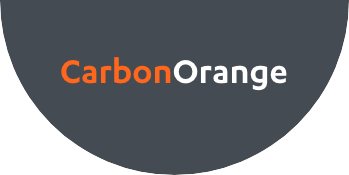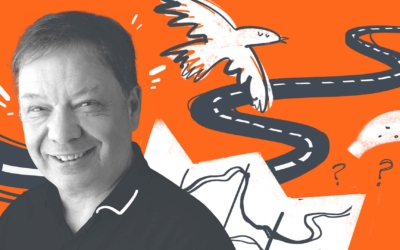What led you into doing what you do?
There are two strings to strong branding as I see it, creativity and consistency and it was the creativity bit that drew me in. First and foremost, I love to challenge someone saying “We’ve got this stuff. We make these things we don’t know what to call them. We’re developing a new whatever.” Great to be involved with those blue-sky thinking projects. And equally, if somebody’s got an existing brand business, and they’ve got some blockers, to have the opportunity to help them reframe that. It’s a great journey to be on, primarily because it’s about human values and how you can express those through colour, language, shapes, graphics. There’re so many ways that you can do it and I find all of that really fascinating, and I enjoy the exploration, the creative process.
The second bit is the consistency piece which I often find clients can be a bit less than strict on. Their heads get quickly turned by what their competitors are doing. I find being an external sounding board is the best place to be, from my point of view. I’ve watched people who are part of internal teams and the struggle that they’ve had as the direction ebbs and flows whereas externally, I think that you’re more empowered to say to somebody, ‘look, this is the view from outside of the business. This is the distance piece that your customers are seeing. And it’s really important that we maintain consistency going forward.’ Yes, there’s always going to need to be room to be creative and do fresh things with it. But it’s more of an evolution rather than revolution for most businesses anyway. Unless you’ve got massive money to spend, there are not many businesses that can afford to suddenly just chop and change
Is there anything specific about helping businesses develop this style that gets you excited, what about the process really grabs you?
It’s that whole piece of reimagining the thinking that’s gone around an existing brand or product that’s being developed. As somebody builds and creates a business or a thing, they tend to get closer and closer and get sucked into it, they end up right on top of it. Then that person or that team is not very well placed to understand how that object or service might fit in to the bigger world or sector they may be in, because they’ve been living and breathing it, it’s their baby and their vision can be quite clouded.
Being able to have that distance again, it’s important you can say to people, ‘Okay, this is amazing what you’ve got, but where does this sit within the existing product line-up, the range, the sector’, whatever it might happen to be, and then start to challenge some of their thinking that might sit around that, because I don’t think there’s anything to be gained by being a yes person all the way through. If a client is coming to you, and literally just looking for you to validate every piece of their thinking, then you’re not really doing your job. That’s not to say that you’re going out of your way to deliberately challenge, quite the opposite. Being professional and saying ‘Right, I understand that piece of thinking that we need to do the research around it just to make sure that it’s valid within your customer perception of the product or service’ because a client has got their view of what it is they’re doing but customer perceptions are different, and how you mitigate those two is important.
And it varies from b2c to b2b products. In terms of the way it can be done b2b is very different, although has become much more kind of consumer led in terms of the way it’s gone, I would argue these days that the differences between those channels they’re incredibly subtle, compared to what they once were. When you look back at tech businesses, even just a decade ago, you’re like wow I can’t believe that they were just putting out things that were as cold and harsh.
That whole piece of thinking about what human values and how that connects to the customer profiles and personas, however that might look. There’s no definitive path, it’s nice to add value to things, at the end of the day we’re talking about marks on screens, on pieces of paper or boxes whatever they might happen to be, they’re visual cues or words that are going to evoke all kinds of emotion in the recipient, through whatever channel that might be. That’s an incredibly powerful thing to do, and it’s a great privilege depending on what the brands are that you’re working with, to be asked to help form the messaging that sits around.
Bonus question! What is your favourite fruit?
Raspberries, because I quite like the kind of sweet but bitter. If I was to be pushed on other things I would go more, citrus and go more towards lemons.
Interesting! Next, back to the serious stuff. Your favourite kind of clients for you to work with.
It’s people that are coming to you because they see the value that you’re going to bring to the process; the people who are not looking just for pure validation of what they’ve done. Whilst, whatever it is you’ve made is fantastic, the problems they solve for a customer might not have even been realised by the producer in the first instance. In many instances highly successful businesses and products have found their own niche, that’s not been necessarily intended, maybe along the way and it’s only been as a result of them communicating out and looking at customers, and really understanding what it is that they want. I think there’s a lot of businesses that make massive assumptions around what it is that their customers come to them for, and what they see as their actual brand values. Because whilst every business will have its positioning that it’s putting out there, if you ask the customer what their value to that brand is, it’s quite often quite different from what they have thought, and that is really important. I think the research, the understanding of customer profiles, and what problems you’re solving. Often, above and beyond, where the core service or product may be as well. I think that’s what’s interesting, you’re defining a path that’s maybe not there to start with or a path that’s trying to become refreshed and new, and it’s that constant evolution. Just a love of communication, and the arts because we’ve never had to greater access to so many ways that you can engage, and the digital world is great from that point of view but of course it also means it’s harder than ever in lots of ways because there’s a lot more noise.
What brands out there that you’re in awe of who are doing this style thing really well?
Well, I think that we can say whether you like it or not, Apple has done a fantastic job, and you look back, that’s not just something that’s being developed at a certain point, you look back to the early days of the business when very few people had heard of it, they always had a quirk to what they were doing and they were happy to lead with a slightly quirky, slightly different angle, and perhaps as the business has grown, the strength and validation around that has just become more and more apparent. From a brand building point of view there’s no denying the strength of what they’ve done.
Another one is Kellogg’s – huge business. To this day, you see that k shape, that letter form you know exactly what it is. And that’s been all about consistency; yes, there’s been various iterations of it over the years, but still, walking down a supermarket aisle, you see that shape you know exactly what you’ll get. If you didn’t know anything about cereal and had never eaten it, it’s this confidence piece because you can see the whole range with the consistency.
Another example I would give but I think it’s gone wrong in the last three years is VW – an iconic brand. That sector is going through massive change, and obviously, all the manufacturers are trying to adapt to it, what they’ve done in the last three years, feels a little bit disjointed. Compared to when you look back historically how strong that was as a brand, it just feels now that it’s not really 100% sure about where it’s going. What they did with the visual identity, talk about ‘if it isn’t broke, don’t try to fix it’. Why change it? And it was already there and was so iconic that whatever you did to it was going to be a tricky piece to pull off. The Press particularly weighed in, really harshly. When there’s a new identity released, they tend to focus on the money, and not what the outcome was. They don’t understand all the simple things that sit around that in terms of values and communication. When you look at the VW stuff, it’s hard to say when you’ve got that amazing amount of collateral behind you why would you throw some of it away. I appreciate they are going into a new evolution, but it just feels like it’s thrown away a heck of a lot of the good stuff. Which is strange to me, but I’m sure there’ll be some very good validation, and who knows, we may be just seeing an interim interpretation of things that’s going to take it to an entirely different level and I’ll be eating my words, in a few months or years’ time.
So the last question is, what effect does style have on the next step of the pyramid, would you say?
In the pyramid model is everything is interconnected – it’s a constant building. And that is a major part of branding in general, there’s no just putting one piece out there and saying, that’s enough – if you’re doing things in isolation, it’s never going to work. You’ve got to be thinking big picture stuff and genuinely trying to build something. You are almost putting layers in place to give depth to that piece that goes out there. The moment that you move from the verbalization to marks, and icons is always fascinating, because people will have their own biases around things such as colour, fonts, form, you know, these are all things that designers constantly learn about when they’re presenting. It’s understanding customer expectations, potential customer expectations, and making sure that you’re delivering something that answers both of those. In some instances it depends on the client, how customer focused they are, if they’re really customer focused, then you’re going to be able to lead it more that way but it is really probably one of the most exciting parts, once you’ve got positioning statements ideas, name, development, and everybody’s kind of quite energised at that point, both sides of the relationship, the supplier and the client, there’s a real kind of energy going. And then there’s a great first go and at that point, the client and we start moving into what that means as a visual, how that visual narrative can be delivered, and there are many different ways that could be. And that’s when it is super, super exciting.
You’ve also got to be focused because it’s easy to think it’s just great and find some of that exploration can be a bit leftfield, and it depends on the project that you’re doing, or the service that leftfield stuff could be spot on. But it’s a process. It’s a case of, you know, we’re putting stuff out there, we’re also having to think about what are the things that aren’t right and then validate which directions we do go in. The great relationships and great stuff that I’ve enjoyed working on is when you have those helpful conversations about the work that you’ve presented, and there’s a lot of respect from both sides, and quite often there will be little nuggets that come in from both sides that make all the difference to what comes out at the far end. I don’t think it should be dictatorial from one side or the other. I think everybody’s got a lot of value to add into the process and it can literally sometimes be just throwaway comments like, can I see what that looks like reversed out of black or whatever and you say yeah okay let’s do that. And there’ll be a whole new avenue of thought itself. That’s a very important part of the process but then you’re also into the trickiest part as well because you can’t keep going forever. There is a real risk that you can start to just think let’s just have this fantastic experimentation time. You’ve got to put some meaningful deliverables at the back of that and some timeframes because otherwise it just becomes a bit of a flight of fancy.
The takeaways:
Creativity, consistency, communication, customer perception and everything is connected!






